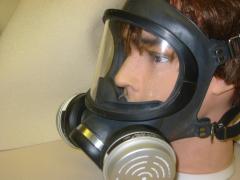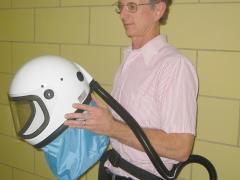 Photo provided by the Central States Center for Agricultural Safety and Health (CS-CASH)
Photo provided by the Central States Center for Agricultural Safety and Health (CS-CASH)

Use the following format to cite this article:
Respiratory illnesses associated with agriculture. (2012) Farm and Ranch eXtension in Safety and Health (FReSH) Community of Practice. Retrieved from http://www.extension.org/pages/63439/respiratory-illnesses-associated-with-agriculture.
A farmer’s or rancher’s life is not always associated with the great outdoors and fresh air. In production agriculture, farmers and ranchers can be exposed to toxic gases and contaminated particulate matter that can cause short- and long-term health problems. The three main respiratory illnesses associated with production agriculture are:
- farmer’s lung,
- silo filler’s disease, and
- organic dust toxicity syndrome.
Farmer’s Lung
Farmer’s lung, or farmer’s hypersensitivity pneumonitis (FHP), is a noninfectious allergic disease that affects normal lung function. It results from the inhalation of mold spores from moldy hay, straw, or grain. The mold spores that cause farmer’s lung are microorganisms that grow in baled hay, stored grain, or silage with high moisture content (30%). Exposure to mold spores is greater in late winter and early spring.
Mold spores, which are not always visible, are so tiny that 250,000 spores can fit on the head of a pin. Because the spores are so small, it is easy for a farmer or rancher to breathe in millions of spores in a few minutes. Due to their size, the mold spores easily move into and settle in the lower part of the lungs.
Symptoms usually begin four to six hours after exposure to mold spores and can include increased coughing, coughs that bring up mucus, fever, chills, shortness of breath, discomfort in the lungs, and a tightness and/or pain in the chest. Symptoms may become most severe from 12 to 48 hours after exposure.
Allergic reaction to mold spores can be acute or chronic. An acute attack typically resembles the flu or pneumonia. Chronic reactions can resemble a nagging chest cold. A producer who has been diagnosed with farmer’s lung should avoid additional exposure to mold spores; otherwise, the producer’s condition could worsen and render him or her inactive. In some cases, farmer’s lung can be fatal.
If you think that you may have farmer’s lung, contact your physician and explain your symptoms and occupation. If your physician is not familiar with farmer’s lung, you may need to request a referral to a specialist for testing, diagnosis, and treatment.
To reduce the risk of contracting farmer’s lung, take the following steps:
- Identify and minimize contaminants in your work environment.
- Avoid exposure to contaminants and mold spores.
- Limit the growth of mold spores by using mold inhibitors.
- Harvest, bale, store, and ensile grains at the recommended moisture level to reduce mold growth.
- Convert from a manual to a mechanical or automated feeding or feed-handling system to reduce the release of airborne mold spores.
- Move work outside and avoid dusty work in confined areas whenever possible.
- Mechanically remove air contaminants through ventilation with fans, exhaust blowers, and so on.
- Wear appropriate respirators, dust masks, or other personal protective equipment (PPE). Click here to learn more about respiratory PPE.
Silo Filler’s Disease
Silo filler’s disease results from inhaling nitrogen dioxide, a silo gas produced during the silage fermentation process. Although a producer who has been exposed to silo gases may not experience symptoms, damage to the lungs may still have occurred. Fluid can build up in a person’s lungs 12 hours after exposure to nitrogen dioxide. Cough, hemoptysis (coughing up blood from the respiratory tract), dyspnea (shortness of breath), and chest pain can occur after an exposure to 20 ppm, a moderate level of nitrogen dioxide. This concentration has been designated by the National Institute for Occupational Safety and Health (NIOSH) as immediately dangerous to life and health (IDLH). Exposure to higher concentrations (greater than 100 ppm) can result in pulmonary edema (fluid accumulation in the lungs) and in swelling in the lungs, leading to long-term respiratory problems or death. Lower concentrations of 15 to 20 ppm are considered dangerous and can cause respiratory impairment.
If you have been exposed to silo gases, even a small amount, seek immediate medical attention.
To reduce exposure to nitrogen dioxide in silo gases, refrain from entering a silo for ten days to three weeks after filling is complete. If entry is necessary after the three-week period, run the silo blower for a minimum of 30 minutes prior to and during entry, and use a portable gas monitor to continually monitor the gas and oxygen levels in the silo. Click here to learn more about silo gases and how to reduce the risk of exposure.
Organic Dust Toxicity Syndrome
Organic Dust Toxicity Syndrome (ODTS), also called grain fever, toxic alveolitis, or pulmonary mycotoxicosis, is caused by exposure to very large amounts of organic dust. Certain agricultural areas may have large amounts of organic dust: grain storage, hog barns, poultry barns, and cotton-processing areas.
The onset of ODTS can occur four to six hours after exposure, and symptoms can be similar to those of acute farmer’s lung and may include cough, fever, chills, fatigue, muscle pain, and loss of appetite. People who have experienced ODTS and who experience additional exposures to organic dust have an increased risk for respiratory problems and the potential for developing chronic bronchitis. Producers can become very sick from ODTS, but most people completely recover. Occurrences of ODTS are underreported because symptoms often resemble the flu or other mild illnesses.
You can reduce your risk of contracting ODTS by using a respirator to decrease exposure to organic dust. Click here to learn about the different types of respirators used in production agriculture. Implement best management practices to maintain good air quality in confinement buildings for swine and poultry.
Use the following format to cite this article:
Respiratory illnesses associated with agriculture. (2012) Farm and Ranch eXtension in Safety and Health (FReSH) Community of Practice. Retrieved from http://www.extension.org/pages/63439/respiratory-illnesses-associated-with-agriculture.
Sources
Atia, A. (2004) Agri-Facts: Silo gas (NO2) safety. Alberta Agriculture, Food, and Rural Development. Retrieved from http://www1.agric.gov.ab.ca/$department/deptdocs.nsf/all/agdex9036/$file/726-1.pdf?OpenElement.
Cyr, D. and Johnson, S. (2002) Upright silo safety. University of Maine Extension. Retrieved from http://umaine.edu/publications/2305e/.
Farmer’s lung. (2008) Canadian Centre for Occupational Health and Safety. Retrieved from http://www.ccohs.ca/oshanswers/diseases/farmers_lung.html.
Grisso, R., Gay, S., Hetzel, G., and Stone, B. (2009) Farmer’s lung: Causes and symptoms of mold- and dust-induced respiratory illness. Virginia Cooperative Extension. Retrieved from http://www.pubs.ext.vt.edu/442/442-602/442-602.html.
Kirkhorn, S. and Garry V. (2000) Agricultural lung diseases. Environmental Health Perspectives. Retrieved from https://www.ncbi.nlm.nih.gov/pmc/articles/PMC1637683/.
Murphy, D. (2013) Farm respiratory hazards. Pennsylvania State University Cooperative Extension. Retrieved from https://extension.psu.edu/farm-respiratory-hazards.
Von Essen, S., Andersen, C., and Smith, L. Organic dust toxic syndrome: A noninfectious febrile illness after exposure to the hog barn environment. Journal of Swine Herd Health and Production. 2005; 13(5): 273-276. Retrieved from http://www.aasv.org/shap/issues/v13n5/v13n5p273.pdf.





